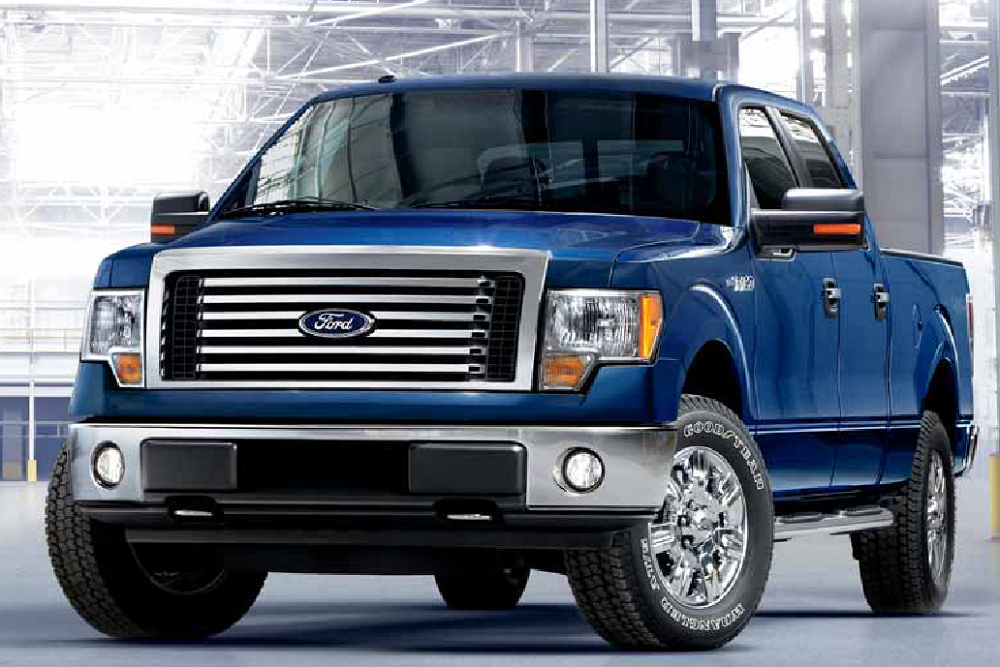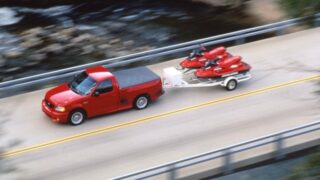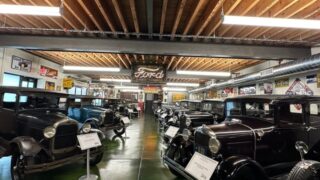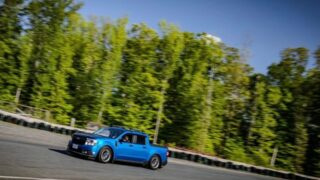Ford Truck History Part 10: 2009-2014
Ford soldiers on through the worst financial crisis it’s ever witnessed, remaining strong in the face of looming disaster.
Welcome to is Part 10 of our Ford truck history series. Here’s where we’ve been so far:
Part 1: F Series Origins
Part 2: 1953-1960
Part 3: 1961-1972
Part 4: 1973-1979
Part 5: 1980-1986
Part 6: 1987-1991
Part 7: 1992-1996
Part 8: 1997-2003
Part 9: 2004-2008
By this point in Ford Truck history, the F-series lineup represented America’s best-selling truck – if not vehicle in general – for decades. This popularity brings inherent challenges related to production and versatility. Namely, how does one produce a truck capable of satisfying the needs of so many individual preferences across such a broad customer base? Ford’s answer to this complex problem lay in its push to further develop a modular, universal platform for each vehicle class. Namely, these platforms are the T1 for full-size trucks, D4 for midsize crossovers, CD2 for compact SUVs, and T6 for Pan-Asian/Oceanic markets (more on the T6 when we hit the 2019 model year).
As mentioned in the prior article, this trend started largely with powertrains, specifically the Ford Modular engine. This simple, reliable SOHC design quickly permeated multiple model lineups, greatly simplifying production and parts-commonality. Ford’s entire model range, in fact, received heavy facelifts beginning in the mid-2000s, with styling elements shared across all vehicles. This created an easily recognizable fascia and fundamental “character” throughout, a byproduct of this consolidation that worked to Ford’s advantage. However, these changes didn’t occur just because Ford wanted to try something different. So before we get into the details of how each truck adapted to this new world, first we have to briefly establish a timeline and discuss the platforms themselves.
Baptism of Fire
The original Ford T-platform made its debut in August 2006 with the U324 Expedition. Broadly speaking, Ford developed the platform to provide the basis for the new full-size trucks from now on. Essentially, they constructed the platform from a modified ladder-frame used in the eleventh-gen F-series. For Ford, this platform absolutely had to be successful. And the main reason why was because 2006 marked Ford’s largest ever annual loss, an eye-watering $12.7 billion. Not only that, but the year after, the US fell under the worst financial crisis since the Great Depression. With the housing bubble burst and a widespread banking crisis in 2008, the automotive industry’s liquidity plummeted. This directly led to competitors Chrysler and GM very nearly collapsing, placing Ford in a precarious position. However, in spite of the ongoing crisis, all three companies proposed various plans to resurrect the industry. And very long story short, all three companies underwent significant changes but ultimately made it through to the end.
For Ford, this end goal meant a dramatic shift to reflect an emerging giant: the crossover. Of course, Ford’s best-seller remained the F-series. But starting in 2007, Ford underwent a full model-line revision in an effort to recoup its losses. Amazingly, this actually paid off in the short-term, with Ford reporting a $750 million profit in Q2 2007. So although by no means out of the woods, Ford continued moving inventory, no doubt helped by the advent of its modular-based construction. And while we won’t get further into the politics regarding this crisis, it remains crucial to Ford’s story. Because without these modular platforms, the decade might’ve closed with Ford in a far worse situation.
Lucky Number Twelve
The twelfth-gen F-series began life way back in 2003. This goes way back to tenth-gen production dates, when the modular platforms were first being developed. Once the eleventh-gen design froze, Ford essentially began work almost immediately for its replacement. Uniquely, Ford intended to scale down the size, reintroducing the F-100 name for the first time as well. Ultimately, the truck did, in fact, end up the smallest truck in America in 2011. Development centered around essentially marrying the concepts of a premium car with the utility of a truck. In short, Ford banked on prior marketing trends toward a more luxury-based truck. Furthermore, Ford marketed the truck as efficient and comfortable, focusing on smooth, practical engines. Subsequently, this also meant dropping manual transmissions entirely, a feature yet to return, and the development of the new EcoBoost powerplant.
The initial models marked the first time a V8 with automatic transmission came standard on all F-150 models; V6’s were no longer available.
This major focus shift paid off in dividends for Ford. Upon its release, the twelfth-gen represented a lighter, stronger, and more premium upgrade over its predecessor. Featuring no fewer than ten individual trim levels, the modularity provided a breadth of options to suit many occupations and sensibilities. Alongside this, Ford debuted an all-new powertrain lineup for the 2011 model year. This includes a base 3.7L Duratec V6, the debut of the 5.0L Coyote V8, and the famous EcoBoost 3.5L turbo V6. If you wanted something even meatier, you could even order the 6.2L off the Super Duty (more of that later). After various teething issues (we’re looking at you, Duratec water pump), each of these engines grew in reliability and popularity, in particular the Coyote and EcoBoost.
Pat Schiavone designed this generation, the man jointly responsible for the design of the eleventh-gen F-series as well.
Ultimately, the F-Series proved incredibly popular with its all-new selection of engines and trim options. Factoring in an overall deficit caused by the financial crisis, the truck sold remarkably well. For Ford, this single factor meant that the F-150 in particular carried a significant chunk of Ford’s burdens through the crisis, its sales greatly benefiting the company in terms of maintaining its liquidity. Though that proved easy enough for the F-150. After all, as a well-designed pickup, it was quite adept at carrying heavy loads.
Walking Tall
Meanwhile, the Super Duty received not one but two complete generations during this timeframe. Beginning with the second-gen (MY 2008-2010), Ford updated the truck virtually head-to-toe. Ford’s exterior restyling mimicked the F-Series’ styling cues, featuring a more commanding, bolder appearance. And the interior was completely redesigned, now incorporating the same luxury features as its light-duty counterpart. Everything from instrumentation and seats to upholstery and fitment improved dramatically. Not the least of which because the model was actually due to release in 2007 but due to quality control issues was pushed back to 2008. And the last thing Ford needed right now was a bad reputation with the hard-working Super Duty customers.
2011 Super Duties optionally came equipped with a locking differential, the only such Super Duty boasting this feature.
Coupled with its 2011 revision to the light-duty line, Ford likewise reworked the big stuff. But this time, they went above and beyond and produced a proper next-generation truck. Now featuring all-new engines and a totally new body, the third-gen Super Duty produced rave reviews, placing it above competitors Ram HD and Silverado HD. This model also debuted the new Boss 6.2L V8 alongside perennials Triton V10 and PowerStroke. Ford coupled all engines to its 6R140 6-speed automatic with manual-mode. Larger vehicles optionally received the 6.8L V10 coupled to a 5-speed auto. Uniquely, if one ordered a diesel, the transmission featured a “Live Drive” system. This means that the transmission has no torque converter, instead being connected directly to the crankshaft. This system helps eliminate a fraction of parasitic drag from actual torque figures, substantially improving low-end power delivery.
Ford produced the third-gen Super Duty until 2016 in four trim levels and with various ratings of power and load capacity. More substantially, most of the developments, including powertrains and accessories, were conducted in-house. For example, the new PowerStroke became entirely produced by Ford from start to finish. This helped shed development costs and improve production times.
The Other End of the Spectrum
But what about the smaller vehicles? Well, the Crossover Era’s reaching its adolescence. As such, Ford’s bread and butter in this department shifts most drastically of all. Development focused mainly on the creation of a small, midsize, and full-size crossover, becoming the Edge, Flex, and Explorer respectively. These functionally replaced several prior models, including Ford’s entire minivan line. The smallest of them all, the Escape, entered its second generation in 2008. Classified as a compact SUV, the second-gen Escape (and sibling Mercury Mariner) continued the simple, blocky aesthetic of the original, now incorporating all-new interior and some exterior changes. These included an overall more refined appearance and a front fascia reminiscent of the fourth-gen Explorer.
Going one step up, the new Edge hit dealerships in 2007. More or less, the Edge represented a crossover alternative to a mid-size sedan. Indeed, the Edge shared many underpinnings with the Fusion. Interestingly, the Edge debuted a Sport trim featuring the 3.7L Duratec V6 in 2009. Ford intended this model to compete with the likes of other sporty crossover trims cropping up at the time, such as the Honda Element SC. Thanks to high sales figures and low production costs from shared parts lines, the first-gen Edge remained in production from 2006 until 2014, receiving a facelift along the way.
Moving up from the Edge sits the Flex, Ford’s new model targeting minivan owners. Debuting the D4-platform, the Flex replaces the Taurus X as a new 3-row seater MPV. Its unique blocky styling helps distinguish it not just from other crossovers, but from contemporary Ford vehicles in general. Sitting alongside is Ford’s fifth-gen Explorer, the first ever featuring a unibody. Representing the full-size crossover option, the Explorer also featured the widest variety of options and potential applications. This Explorer became the infamous police interceptor, featuring a 3.7L Cyclone V6 and AWD powertrain. However, the Explorer’s growth of proportions left a gap in Ford’s production line. Suddenly, there weren’t any midsize SUVs left, a gap which persisted until 2020 with the Bronco. Nevertheless, the Explorer sold particularly well. And all of the above vehicles distinguished themselves in family-oriented markets, with excellent safety ratings and features across the board.
Risen from the Ashes
Ford finally recouped their losses from the financial crisis largely thanks to these vehicles. Each one of them features modular components with common parts interchangeability between families, leading to minimal production costs and delays. Furthermore, Ford’s partnerships with companies like Mazda and Land Rover continued bearing fruit, with vehicles like the Mazda Tribute and Ford Escape selling well internationally. The 2011 model year proved as one of Ford’s most pivotal, if not because of the crisis, then certainly for the new goodies. With ubiquitous engines like the Coyote and EcoBoost finding their way into trucks, the further development of the PowerStroke, or the debut of several new platforms, Ford was truly on a roll. And come next generation, this only built momentum for the trucks, in particular the F-Series.
However, the eagle-eyed among you might’ve noticed a particular absence. There is one truck left untouched: the Raptor. This truck and its heritage deserve its own entirely separate article as the history encompasses too broad of a scope. So be sure to look out for that one coming soon.
Brochures used: 2009-2014 Ford F-150, 2011 Ford Full Line, 2014 Ford Explorer, 2009 Ford Escape, 2009 Ford Edge, 2009 Ford Super Duty, 2011 Ford Super Duty. Hi-res images available at: Ford Heritage Vault

















